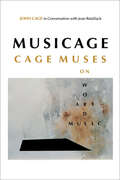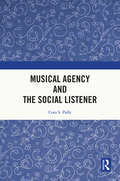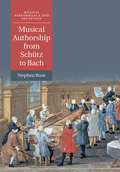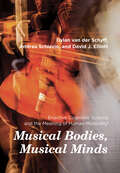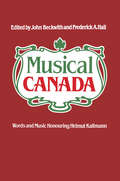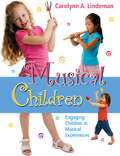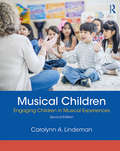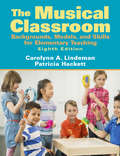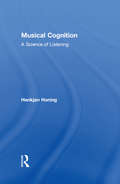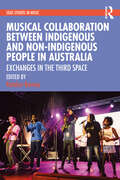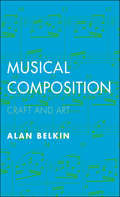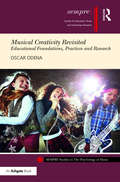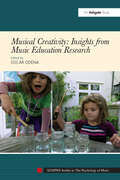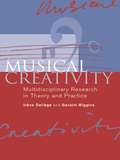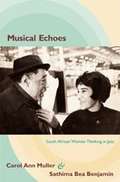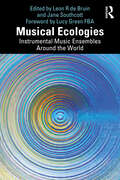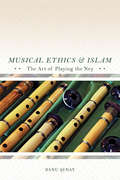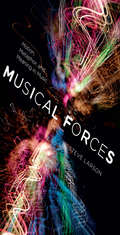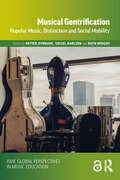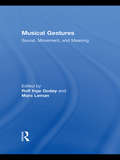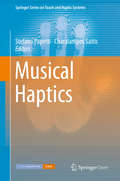- Table View
- List View
Music: Why It Matters
by Nicholas CookAs countries went into lockdown in 2020, people turned to music for comfort and solidarity. Neighbours sang to each other from their balconies; people participated in online music sessions that created an experience of socially distanced togetherness. Nicholas Cook argues that the value of music goes far beyond simple enjoyment. Music can enhance well-being, interpersonal relationships, cultural tolerance, and civil cohesion. At the same time, music can be a tool of persuasion or ideology. Thinking about music helps bring into focus the values that are mobilised in today’s culture wars. Making music together builds relationships of interdependence and trust: rather than escapism, it offers a blueprint for a community of mutual obligation and interdependence. Music: Why It Matters is for anyone who loves playing, listening to, or thinking about music, as well as those pursuing it as a career.
Musicage: Cage Muses on Words, Art, Music
by Joan Retallack John Cage"I was obliged to find a radical way to work -- to get at the real, at the root of the matter," John Cage says in this trio of dialogues, completed just days before his death. His quest for the root of the matter led him beyond the bounds of the conventional in all his musical, written, and visual pieces. The resulting expansion of the definition of art -- with its concomitant emphasis on innovation and invention -- earned him a reputation as one of America's most influential contemporary artists. Joan Retallack's conversations with Cage represent the first consideration of his artistic production in its entirety, across genres. Informed by the perspective of age, Cage's comments range freely from his theories of chance and indeterminate composition to his long-time collaboration with Merce Cunningham to the aesthetics of his multimedia works. A composer for whom the whole world -- with its brimming silences and anarchic harmonies -- was a source of music, Cage once claimed, "There is no noise, only sounds." As these interviews attest, that penchant for testing traditions reached far beyond his music. His lifelong project, Retallack writes in her comprehensive introduction, was "dislodging cultural authoritarianism and gridlock by inviting surprising conjunctions within carefully delimited frameworks and processes." Consummate performer to the end, Cage delivers here just such a conjunction -- a tour de force that provides new insights into the man and a clearer view of the status of art in the 20th century.
Musical Agency and the Social Listener
by Cora S. PalfyMusic as a narrative drama is an intriguing idea, which has captured explicit music theoretical attention since the nineteenth century. Investigations into narrative characters or personae has evolved into a sub-field—musical agency. In this book, Palfy contends that music has the potential to engage us in social processes and that those processes can be experienced as a social interaction with a musical agent. She explores the overlap between the psychological processes in which we participate in order to understand and engage with people, and those we engage in when we listen to music. Thinking of musical agency as a form of social process is quite different from existing theoretical frameworks for agency. It implies that we come to musical analysis by way of intuition—that our ideas are already partially formed based on our experience of the piece (and what it makes us feel or how it makes us sense it as any other) when we choose to analyze and interpret it. Palfy’s focus on social processes is a very effective way to pinpoint when and why it is that our attention is captured and engaged by musical agents.
Musical Authorship from Schütz to Bach (Musical Performance and Reception)
by Stephen RoseWhat did the term 'author' denote for Lutheran musicians in the generations between Heinrich Schütz and Johann Sebastian Bach? As part of the Musical Performance and Reception series, this book examines attitudes to authorship as revealed in the production, performance and reception of music in seventeenth-century German lands. Analysing a wide array of archival, musical, philosophical and theological texts, this study illuminates notions of creativity in the period and the ways in which individuality was projected and detected in printed and manuscript music. Its investigation of musical ownership and regulation shows how composers appealed to princely authority to protect their publications, and how town councils sought to control the compositional efforts of their church musicians. Interpreting authorship as a dialogue between authority and individuality, this book uses an interdisciplinary approach to explore changing attitudes to the self in the era between Schütz and Bach.
Musical Biography: Towards New Paradigms
by Jolanta T. PekaczMusical biography has rarely been an object of theoretical and methodological reflection. Our present-day perception of the lives of prominent composers and performers of the past has been largely formed by cultural and political assumptions of nineteenth-century biographers and their twentieth-century followers. While older biographies are being scrutinized for veracity and 'updated' with new evidence, their historiographical premisses and narrative techniques remain largely unchallenged. The epistemological upheavals in the humanities since the 1960s have generated a body of theoretical thought that has undermined many of the assumptions of traditional biography. Consequently, many of these assumptions have lost their hold as viable underpinnings for present-day scholarly biography. For example, the accumulation of facts is no longer believed to bring us closer to an understanding of the subject; nor are the traditional views of the unified self and the self as a foundational idea taken for granted. This volume brings together musicologists and historians who explore, through individual case studies, the rich potential of these new theories for writing musical lives. The authors of this volume examine how the insights provided by these theories illuminate our critical reassessment of older biographies - and the interpretations of musical works these biographies were used to construe - and help forge new approaches to musical biography. The authors also explore the functions musical biographies served in different historical contexts, the relevance of biography for musical criticism, the reliability of archival evidence, the ethics of biography, the demands placed on biography by feminist and gender history, and the new possibilities offered by cinema. The contributors to this volume challenge the view that biography has little importance for music history, analysis, and criticism. Collectively, they reassert biography's centrality and relevance, and dem
Musical Bodies, Musical Minds: Enactive Cognitive Science and the Meaning of Human Musicality
by David J. Elliott Dylan van der Schyff Andrea SchiavioAn enactive account of musicality that proposes new ways of thinking about musical experience, musical development in infancy, music and evolution, and more.Musical Bodies, Musical Minds offers an innovative account of human musicality that draws on recent developments in embodied cognitive science. The authors explore musical cognition as a form of sense-making that unfolds across the embodied, environmentally embedded, and sociomaterially extended dimensions that compose the enactment of human worlds of meaning. This perspective enables new ways of understanding musical experience, the development of musicality in infancy and childhood, music&’s emergence in human evolution, and the nature of musical emotions, empathy, and creativity. Developing their account, the authors link a diverse array of ideas from fields including neuroscience, theoretical biology, psychology, developmental studies, social cognition, and education. Drawing on these insights, they show how dynamic processes of adaptive body-brain-environment interactivity drive musical cognition across a range of contexts, extending it beyond the personal (inner) domain of musical agents and out into the material and social worlds they inhabit and influence. An enactive approach to musicality, they argue, can reveal important aspects of human being and knowing that are often lost or obscured in the modern technologically driven world.
Musical Canada
by John Beckwith Frederick A. HallThe foremost historian of Canadian music and musical life, Helmut Kallmann is the inspiration for this volume. Its twenty-three contributions, written by prominent composers and writers representing many different regions and both national languages, present a cross-section of current work in historical research, bibliography, analysis, criticism, and creative composition.Among the subjects covered are bibliographical and historian research on recent musical findings from New France and on early musical activities in various Canadian cities and regions; critical appraisals of Canadian composers and performers; and surveys of Canadian musical organizations and their programs. Four short compositions have been written especially for the volume. The title is drawn from two early Canadian musical periodicals, the English-language Musical Canada and the French-language Le Canada musical. As those journals did for their time, so this volume provides a contemporary overview of Canadian music and music scholarship.
Musical Children, CD: Engaging Children in Musical Experiences
by Carolynn LindemanMusical Children: Engaging Children in Musical Experiences by Carolyn Lindeman is the only text that focuses on the teaching of preschool and kindergarten students and the important role music plays in a their educations and lives. Music educators are increasingly recognizing the importance of teaching musical skills as early as the preschool years. This book presents the latest research emphasizing real life applications so that teachers can achieve their goal of creating more musically creative children. The book presents 25 strategies for engaging children who are learning music based on the latest Music Educators National Conference (MENC) standards. It includes reproducible student activity charts, a song selection of 40 notated melodies, a collection of chants, and resource materials for any new teacher to reference. Musical Children is not only an excellent text in any Music Education classroom, but an excellent resource for any preschool or kindergarten teacher. Written by a leading authority on early childhood music education, the text will be used in courses on Elementary Methods and Fundamentals of Music Education. Audio-CD not for sale. Available for instructors upon request from Sales office
Musical Children: Engaging Children in Musical Experiences (Second Edition)
by Carolynn Lindeman<p><i>Musical Children: Engaging Children in Musical Experiences, Second Edition</i>, is designed for students majoring in early childhood or elementary education, or music education. It highlights the important role music plays in a child’s education and life, offering a practical resource for bringing together music and young children during these important early years. Thirty-seven engaging musical experiences help pre-service and in-service teachers—some who may only have a limited background in music—learn how to make music a part of their students’ daily lives, with strategies that are ideal both in and out of the classroom. Musical Children is an invaluable guide to assist teachers in engaging children in meaningful, joyful, and playful musical experiences. <p> <p>NEW to the second edition: <li>The 2014 National Core Music Standards <li>Updated and expanded prekindergarten chapter <li>Greater focus on music fundamentals <li>Expansion of Dalcroze, Orff, Kodály, and Music Learning Theory approaches <li>Discussion questions and projects for each chapter <li>Addition of an Autoharp, Chromaharp, and QChord instructional unit <li>All 49 audio tracks from the musical experiences now available for online listening, hosted or linked to popular music streaming services</li> <p> <p>A new companion website is home to numerous resources, including all audio files, supplementary notated songs, charts for instrument study, and information on IDEA and children with disabilities./<p>
Musical Classroom: Backgrounds, Models, and Skills for Elementary Teaching
by Carolynn LindemanWith this Eighth Edition, The Musical Classroom celebrates thirty years as a leading resource for future and in-service teachers as they engage children in the exciting world of music! Teachers, with the help of this user-friendly text, can develop the understandings and skills needed to teach elementary school music. The forty-four model lessons are the centerpiece to the book's long-lasting success. A collection of over 170 children's songs from around the world; instructional information for learning to play the recorder, keyboard, guitar, and Autoharp(TM); and the theoretical, pedagogical, and practical backgrounds needed for reaching all learners complete the comprehensive resource of The Musical Classroom. Note: This is the standalone book. If you want the accompanying audio CD, order the ISBN 9781138656703, which is available for separate sale.
Musical Cognition: A Science of Listening
by Henkjan HoningWhy do people attach importance to the wordless language we call music? Musical Cognition suggests that music is a game. In music, our cognitive functions such as perception, memory, attention, and expectation are challenged; yet, as listeners, we often do not realize that the listener plays an active role in reaching the awareness that makes music so exhilarating, soothing, and inspiring. In reality, the author contends, listening does not happen in the outer world of audible sound, but in the inner world of our minds and brains. Recent research in the areas of psychology and neuro-cognition allows Henkjan Honing to be explicit in a way that many of his predecessors could not. His lucid, evocative writing style guides the reader through what is known about listening to music while avoiding jargon and technical diagrams. With clear examples, the book concentrates on underappreciated musical skills-"sense of rhythm" and "relative pitch"-skills that make people musical creatures. Research on how living creatures respond to music supports the conviction that all humans have a unique, instinctive attraction to music. Everyone is musical. Musical Cognition includes a selection of intriguing examples from recent literature exploring the role that an implicit or explicit knowledge of music plays when one listens to it. The scope of the topics discussed ranges from the ability of newborns to perceive a beat, to the unexpected musical expertise of ordinary listeners. The evidence shows that music is second nature to most human beings-biologically and socially.
Musical Collaboration Between Indigenous and Non-Indigenous People in Australia: Exchanges in The Third Space (SOAS Studies in Music)
by Katelyn BarneyThis book demonstrates the processes of intercultural musical collaboration and how these processes contribute to facilitating positive relationships between Indigenous and non-Indigenous peoples in Australia. Each of the chapters in this edited collection examines specific examples in diverse contexts, and reflects on key issues that underpin musical exchanges, including the benefits and challenges of intercultural music making. The collection demonstrates how these musical collaborations allow Indigenous and non-Indigenous people to work together, to learn from each other, and to improve and strengthen their relationships. The metaphor of the “third space” of intercultural music making is interwoven in different ways throughout this volume. While focusing on Indigenous Australian/non-Indigenous intercultural musical collaboration, the book will be of interest globally as a resource for scholars and postgraduate students exploring intercultural musical communication in countries with histories of colonisation, such as New Zealand and Canada.
Musical Composition: Craft and Art
by Alan BelkinAn invaluable introduction to the art and craft of musical composition from a distinguished teacher and composerThis essential introduction to the art and craft of musical composition is designed to familiarize beginning composers with principles and techniques applicable to a broad range of musical styles, from concert pieces to film scores and video game music. The first of its kind to utilize a style-neutral approach, in addition to presenting the commonly known classical forms, this book offers invaluable general guidance on developing and connecting musical ideas, building to a climax, and other fundamental formal principles. It is designed for both classroom use and independent study.
Musical Creativity Revisited: Educational Foundations, Practices and Research (SEMPRE Studies in The Psychology of Music)
by Oscar OdenaHow is creativity understood and facilitated across music education settings? What is the power of creativity in enhancing individual and group learning? How is musical creativity used as a tool for cross-community integration? How can we research the interactions of those engaged in musical activities aimed at creative development? These are just some of the questions addressed in this fascinating new monograph. Musical Creativity Revisited is an authoritative volume of insights from theory, practice-based research and methodological analyses. Its chapters celebrate the diversity of the many different ways in which young and adult learners develop musical creativity. Following on from Musical Creativity: Insights from Music Education Research (Ashgate, 2012) Odena offers novel examples from practice and precise suggestions on how to research it. This book will be an essential point of reference for students, researchers, practitioners and practitioner-researchers interested in music education and creativity across the arts and social sciences. The chapters have been organized into three sections – Foundations, Practices and Research – including examples from in-depth studies focussed on a secondary school in England, higher music education in Spain and out-of-school settings in Northern Ireland. This is a book that will fascinate readers, inspiring them to think deeply about the many different ways in which musical creativity can be developed, its purposes and how to research it.
Musical Creativity in Restoration England
by Rebecca HerissoneMusical Creativity in Restoration England is the first comprehensive investigation of approaches to creating music in late seventeenth-century England. Understanding creativity during this period is particularly challenging because many of our basic assumptions about composition - such as concepts of originality, inspiration and genius - were not yet fully developed. In adopting a new methodology that takes into account the historical contexts in which sources were produced, Rebecca Herissone challenges current assumptions about compositional processes and offers new interpretations of the relationships between notation, performance, improvisation and musical memory. She uncovers a creative culture that was predominantly communal, and reveals several distinct approaches to composition, determined not by individuals, but by the practical function of the music. Herissone's new and original interpretations pose a fundamental challenge to our pre-conceptions about what it meant to be a composer in the seventeenth century and raise broader questions about the interpretation of early modern notation.
Musical Creativity: Insights From Music Education Research (SEMPRE Studies in The Psychology of Music)
by Oscar OdenaHow do we develop musical creativity? How is musical creativity nurtured in collaborative improvisation? How is it used as a communicative tool in music therapy? This comprehensive volume offers new research on these questions by an international team of experts from the fields of music education, music psychology and music therapy. The book celebrates the rich diversity of ways in which learners of all ages develop and use musical creativity. Contributions focus broadly on the composition/improvisation process, considering its conceptualization and practices in a number of contexts. The authors examine how musical creativity can be fostered in formal settings, drawing examples from primary and secondary schools, studio, conservatoire and university settings, as well as specialist music schools and music therapy sessions. These essays will inspire readers to think deeply about musical creativity and its development. The book will be of crucial interest to music educators, policy makers, researchers and students, as it draws on applied research from across the globe, promoting coherent and symbiotic links between education, music and psychology research.
Musical Creativity: Multidisciplinary Research in Theory and Practice
by Irène Deliège Geraint A. WigginsThis collection initiates a resolutely interdisciplinary research dynamic specifically concerning musical creativity. Creativity is one of the most challenging issues currently facing scientific psychology and its study has been relatively rare in the cognitive sciences, especially in artificial intelligence. This book will address the need for a coherent and thorough exploration. Musical Creativity: Multidisciplinary Research in Theory and Practice comprises seven sections, each viewing musical creativity from a different scientific vantage point, from the philosophy of computer modelling, through music education, interpretation, neuroscience, and music therapy, to experimental psychology. Each section contains discussions by eminent international specialists of the issues raised, and the book concludes with a postlude discussing how we can understand creativity in the work of eminent composer, Jonathan Harvey. This unique volume presents an up-to-date snapshot of the scientific study of musical creativity, in conjunction with ESCOM (the European Society for the Cognitive Sciences of Music). Describing many of the different aspects of musical creativity and their study, it will form a useful springboard for further such study in future years, and will be of interest to academics and practitioners in music, psychology, cognitive science, artificial intelligence, neuroscience and other fields concerning the study of human cognition in this most human of behaviours.
Musical Echoes: South African Women Thinking in Jazz
by Sathima Bea Benjamin Carol Ann MullerMusical Echoes tells the life story of the South African jazz vocalist Sathima Bea Benjamin. Born in Cape Town in the 1930s, Benjamin came to know American jazz and popular music through the radio, movies, records, and live stage and dance band performances. She was especially moved by the voice of Billie Holiday. In 1962 she and Dollar Brand (Abdullah Ibrahim) left South Africa together for Europe, where they met and recorded with Duke Ellington. Benjamin and Ibrahim spent their lives on the move between Europe, the United States, and South Africa until 1977, when they left Africa for New York City and declared their support for the African National Congress. In New York, Benjamin established her own record company and recorded her music independently from Ibrahim. Musical Echoes reflects twenty years of archival research and conversation between this extraordinary jazz singer and the South African musicologist Carol Ann Muller. The narrative of Benjamin's life and times is interspersed with Muller's reflections on the vocalist's story and its implications for jazz history.
Musical Ecologies: Instrumental Music Ensembles Around the World
by Jane Southcott de Bruin, Leon RCommunity music around the world reflects the growing and diverse ways humans collectivise and express themselves in ways that articulate our cultural, social, and environmental complexity. Revisiting, redevising, and reimagining some of the field’s approaches, ideologies, and contexts, this co-edited volume investigates beyond generalist intercultural and internationalist concepts to reveal the complexity of social ways people come together to make music and to making music be central to this sociality.The authors explore the role community music plays out around the world and how various instrumentally based music-making communities operate as ecologies that allow notions of social, political, and cultural agency and identity/ies. Chapters cover various instrumental community music ensembles, observing how they, as social microcosms of change and stasis, provide working methods new and old, extol values, and model ethical behaviours that are fluid and dynamic, steadfast and unyielding, and that contribute to the ebb and flow of people and their agency that remains under-researched. Insights are provided on variously functioning ensembles throughout the world, showing how myriad instrumental music communities act as drivers, complex environments, and apparati for musical and social expression that accommodates the musical aspirations of their members.Taken as a whole, this book explores community music as local, glocal, global phenomena, critically discussing the redefinition of community music and what music-making means to people in the twenty-first century.
Musical Ethics and Islam: The Art of Playing the Ney
by Banu SenayAfter the establishment of the Turkish Republic, Turkey's secularized society disdained the ney, the Sufi reed flute long associated with Islam. The instrument's remarkable revival in today's cities has inspired the creation of teaching and learning sites that range from private ney studios to cultural and religious associations and from university clubs to mosque organizations. Banu Şenay documents the years-long training required to become a neyzen—a player of the ney. The process holds a transformative power that invites students to create a new way of living that involves alternative relationships with the self and others, changing perceptions of the city, and a dedication to craftsmanship. Şenay visits reed harvesters and travels from studios to workshops to explore the practical processes of teaching and learning. She also becomes an apprentice ney-player herself, exploring the desire for spirituality that encourages apprentices and masters alike to pursue ney music and its scaffolding of Islamic ethics and belief.
Musical Forces
by Steve LarsonSteve Larson drew on his 20 years of research in music theory, cognitive linguistics, experimental psychology, and artificial intelligence--as well as his skill as a jazz pianist--to show how the experience of physical motion can shape one's musical experience. Clarifying the roles of analogy, metaphor, grouping, pattern, hierarchy, and emergence in the explanation of musical meaning, Larson explained how listeners hear tonal music through the analogues of physical gravity, magnetism, and inertia. His theory of melodic expectation goes beyond prior theories in predicting complete melodic patterns. Larson elegantly demonstrated how rhythm and meter arise from, and are given meaning by, these same musical forces.
Musical Gentrification: Popular Music, Distinction and Social Mobility (ISME Global Perspectives in Music Education Series)
by Sidsel Karlsen Ruth Wright Petter DyndahlMusical Gentrification is an exploration of the role of popular music in processes of socio-cultural inclusion and exclusion in a variety of contexts. Twelve chapters by international scholars reveal how cultural objects of relatively lower status, in this case popular musics, are made objects of acquisition by subjects or institutions of higher social status, thereby playing an important role in social elevation, mobility and distinction. The phenomenon of musical gentrification is approached from a variety of angles: theoretically, methodologically and with reference to a number of key issues in popular music, from class, gender and ethnicity to cultural consumption, activism, hegemony and musical agency. Drawing on a wide range of case studies, empirical examples and ethnographic data, this is a valuable study for scholars and researchers of Music Education, Ethnomusicology, Cultural Studies and Cultural Sociology.
Musical Gestures: Sound, Movement, and Meaning
by Marc Leman Rolf Inge GodøyWe experience and understand the world, including music, through body movement–when we hear something, we are able to make sense of it by relating it to our body movements, or form an image in our minds of body movements. Musical Gestures is a collection of essays that explore the relationship between sound and movement. It takes an interdisciplinary approach to the fundamental issues of this subject, drawing on ideas, theories and methods from disciplines such as musicology, music perception, human movement science, cognitive psychology, and computer science.
Musical Haptics (Springer Series on Touch and Haptic Systems)
by Stefano Papetti Charalampos SaitisThis open access book offers an original interdisciplinary overview of the role of haptic feedback in musical interaction. Divided into two parts, part I examines the tactile aspects of music performance and perception, discussing how they affect user experience and performance in terms of usability, functionality and perceived quality of musical instruments. Part II presents engineering, computational, and design approaches and guidelines that have been applied to render and exploit haptic feedback in digital musical interfaces. Musical Haptics introduces an emerging field that brings together engineering, human-computer interaction, applied psychology, musical aesthetics, and music performance. The latter, defined as the complex system of sensory-motor interactions between musicians and their instruments, presents a well-defined framework in which to study basic psychophysical, perceptual, and biomechanical aspects of touch, all of which will inform the design of haptic musical interfaces. Tactile and proprioceptive cues enable embodied interaction and inform sophisticated control strategies that allow skilled musicians to achieve high performance and expressivity. The use of haptic feedback in digital musical interfaces is expected to enhance user experience and performance, improve accessibility for disabled persons, and provide an effective means for musical tuition and guidance.
Musical Healing in Cultural Contexts
by Penelope GoukHow do people use music to heal themselves and others? Are the healing powers of music universal or culturally specific? The essays in this volume address these two central questions as to music‘s potential as a therapeutic source. The contributors approach the study of music healing from social, cultural and historical backgrounds, and in so doing provide perspectives on the subject which complement the wealth of existing literature by practitioners. The forms of music therapy explored in the book exemplify the well-being that can be experienced as a result of participating in any type of musical or artistic performance. Case studies include examples from the Bolivian Andes, Africa and Western Europe, as well as an assessment of the role of Islamic traditions in Western practices. These case studies introduce some new, and possibly unfamiliar models of musical healing to music therapists, ethnomusicologists and anthropologists. The book contributes to our understanding of the transformative and healing roles that music plays in different societies, and so enables us better to understand the important part music contributes to our own cultures.

